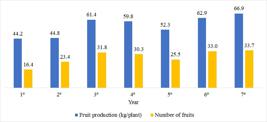Abstract
This study aimed to use the canopy replacement technique to reduce the field evaluation time and to select promising cupuassu tree clones. The study was carried out under field conditions using fifteen-year-old trees. The crowns were replaced using 16 treatments (clones). The experiment was conducted using randomized blocks design with 18 replicates and one plant per plot, during a period of ten years. The following variables were evaluated: average number of fruits, fruit, seed and pulp production (kg/plant) and symptoms of “witches broom” disease. The data were checked for normality followed by analysis of variance. The results highlighted clones 32, 42, 44, 46, 47, 61, 62, 63 and 64, presenting characteristics such as productivity, tolerance to witches’ broom disease and interesting fruit characteristics. The results demonstrate that the technique was effective in the evaluation of cupuassu tree genotypes, since the clones revealed their potential at early stages after establishment in the field. There was a reduction by at least 30% regarding the time needed to evaluate cupuassu tree genotypes. Five clones (32, 42, 46, 61 and 64) already present the potential to be made available to producers, aimed at replacing the canopy of unproductive trees.
Index terms
Theobroma grandiflorum; genetic breeding; clone selection; over grafting; witch broom

 Thumbnail
Thumbnail
 Thumbnail
Thumbnail
 Thumbnail
Thumbnail


